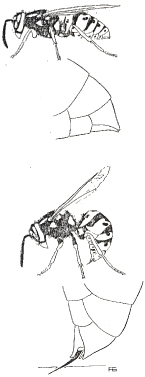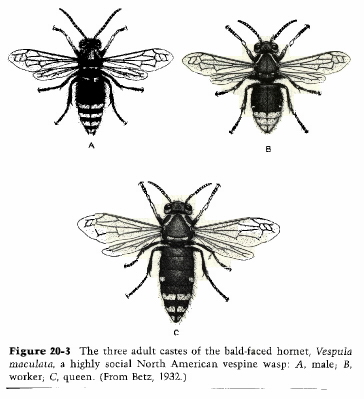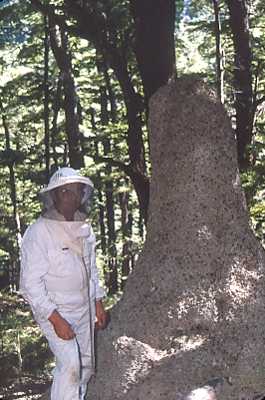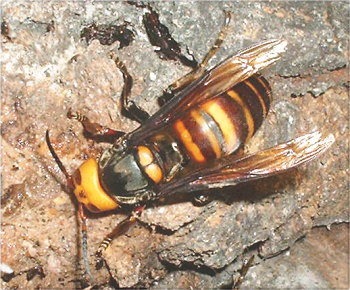
AN INTRODUCTION TO SOCIAL WASPS:
(If you would like to help out, please spread the word around about this website and please send me photos for the guest gallery. Thanks!)
Social wasps are the famous stingers of the insect world. We know them as hornets, yellowjackets, and paper wasps. They belong to the order Hymenoptera (which means "membranous wings"). They are closely related to ants and bees, which are also in the same order. Social wasps live together in communities called colonies. A well established colony of Polistine wasps (common paper wasps) can have two hundred or more individuals living on a nest the size of a man's outstretched hand. An underground yellowjacket nest, on the other hand, can be the size of a bushel basket and sometimes larger. A nest of this size can have five thousand or more hot tempered, stinging insects.
Social wasps use paper (wood pulp) to construct their nests. The process is simple... a wasp collects wood fiber by using its mandibles (mouth parts) to scrape it from worn and weathered wooden fences, buildings, telephone poles, and other sources. Sometimes it collects fiber from man-made paper products such as paper bags or cardboard boxes. The insect then chews the wood and mixes it with saliva. This makes the wood fiber extremely soft and moist. After a period of chewing, the wasp adds the paste to the nest structure and spreads it out with her mandibles and legs. After it thoroughly dries; a type of tough, durable paper is formed.
Most species of social wasps in the USA build their combs horizontally with cells located on the bottom of each one. Though there are a few species of Polistes wasps which hang their combs vertically with the cells facing to one side. These combs are primarily used for brood rearing. Little or no food exists in any of them because most social wasps do not store food. The reason for this is because wasp colonies feed on large numbers of caterpillars, bugs, flies, spiders, etc. and the meat would spoil if the wasps were to store it. In some species such as hornets and yellowjackets, a paper envelope (covering) is built around the combs. This serves as good insulation material since the covering consists of multiple layers of paper sheets. There are air pockets in between each one which help in maintaining a comfortable temperature inside the nest. Certain species of social wasps build open combs without any kind of protective covering, such as the Polistine wasps for instance.
Stinging is an excellent defense in wasp colonies against predators and other possible dangers which present a threat to the nests and their occupants. A stinger is actually a modified egg-laying tube which is connected to a venom sac inside the insect's body. A wasp is quite capable of stinging repeatedly because it can easily withdraw its stinger from the entry point. When a wasp wants to sting, it curves its abdomen downward and punctures the victim's skin with its sharp stinger. Muscles then drive the stinger deeper into the flesh. Meanwhile, venom is being pumped from the venom sac, through the stinger, and into the wound. It is similar to how a hypodermic needle works. Chemicals in the venom cause the pain and irritation from the sting.

Credit for the above illustration goes to the U.S. Department of Agriculture.
Wasps have a life cycle which has four stages:
1. egg,
2. larva,
3. pupa,
4. and adult.
This is called "complete metamorphosis". The entire process from egg to adult takes several weeks to finish.
Wasp colonies have a distinct caste system. It includes:
1. Queens- fertile females which lay eggs,
2. Drones- fertile males which mate with the future queens (by the way, the males do not have stingers and they are born from unfertilized eggs),
3. Workers- infertile females which do the labor of the nest and defend the colony with their stings.

I got this wonderful illustration from a book (NOTE: the name "Vespula maculata" has been revised to "Dolichovespula maculata").
In the United States, social wasps abandon their nests and die in the late fall or early winter when freezing temperatures have set in. Only the young daughter queens which are born (and have mated with the drones) during the present season will hibernate (in attics, basements, tree trunks, etc.) and live through the winter. The queens will begin their new nests in the spring. Old nests are almost never reused. Though there have been unusual cases when yellowjacket colonies have survived mild winters and they reused the same nests year after year. As a result, the colonies and their nests reached tremendous proportions.
Although most people think of wasps as pests, they benefit mankind and the environment in many ways. They help control arthropod pests (flies, caterpillars, bugs, spiders, etc.) by preying on them. This really does help to cut down on the use of harmful pesticides. This is healthier for our environment in the long run. Wasps are also used in research and experiments. In some places in the world, people use the immature stages (larvae and pupae) of wasps as food for a good source of protein. Therefore, the benefits to humans far outweigh the harm which they do.
***IMPORTANT: HORNETS, YELLOWJACKETS, AND PAPER WASPS SHOULD NOT BE NEEDLESSLY KILLED UNLESS THEIR NESTS ARE LOCATED IN "HIGH RISK" AREAS!!!***

Credit for the above diagram goes to the U.S. Department of Agriculture.
*Here are the meanings behind the genus names used for hornets, yellowjackets, and paper wasps:
1. Vespa: hornets such as the "European hornet" (Vespa crabro).
2. Vespula: subterranean-nesting yellowjackets such as the "common yellowjacket" (Vespula vulgaris).
3. Dolichovespula: aerial-nesting yellowjackets such as the "bald-faced hornet" (Dolichovespula maculata). Actually this particular species is not a hornet at all. It is a large, black yellowjacket with white markings.
4. Polistes: common paper wasps such as the "red wasp" (Polistes annularis).
*Here is an interesting fact for you: The largest wasp nest on record measured twelve feet long with a diameter of five feet nine inches! It was discovered on a farm at New Zealand in 1963.

Giant wasp nest photo by: webmaster@landcare.cri.nz
*Here is another interesting fact for you: The largest social wasp on record is the Japanese Giant Hornet (Vespa mandarinia). This awesome creature is one of the most feared species of hornets on earth. It is a very large-sized wasp with a body length of 27 - 45 mm; unbelievable, the queens reach 5.5 cm in length!

Japanese Giant Hornet photo by: ikimono@sci.nhk.or.jp
Click Here To Submit And/Or View Wasp Stories
 |
The Vespids SiteRing This site owned by Hornetboy |
|
| |
Listen To Enigma's Music Here!
Song: "Sweet Lullaby" by Deep Forest